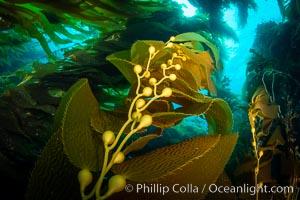
Kelp fronds and pneumatocysts. Pneumatocysts, gas-filled bladders, float the kelp plant off the ocean bottom toward the surface and sunlight, where the leaf-like blades and stipes of the kelp plant grow fastest. Giant kelp can grow up to 2' in a single day given optimal conditions. Epic submarine forests of kelp grow throughout California's Southern Channel Islands.
Species: Giant kelp, Macrocystis pyrifera
Location: San Clemente Island, California
Image ID: 34606
Species: Giant kelp, Macrocystis pyrifera
Location: San Clemente Island, California
Image ID: 34606
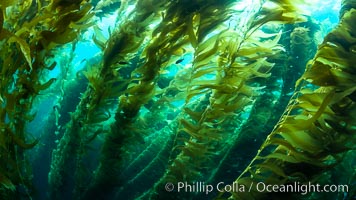
The Kelp Forest of San Clemente Island, California. A kelp forest. Giant kelp grows rapidly, up to 2' per day, from the rocky reef on the ocean bottom to which it is anchored, toward the ocean surface where it spreads to form a thick canopy. Myriad species of fishes, mammals and invertebrates form a rich community in the kelp forest. Lush forests of kelp are found throughout California's Southern Channel Islands.
Species: Giant kelp, Macrocystis pyrifera
Location: San Clemente Island, California
Image ID: 34609
Species: Giant kelp, Macrocystis pyrifera
Location: San Clemente Island, California
Image ID: 34609
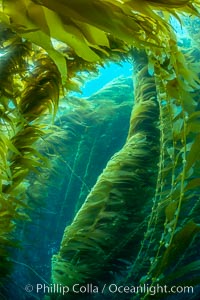
The Kelp Forest of San Clemente Island, California. A kelp forest. Giant kelp grows rapidly, up to 2' per day, from the rocky reef on the ocean bottom to which it is anchored, toward the ocean surface where it spreads to form a thick canopy. Myriad species of fishes, mammals and invertebrates form a rich community in the kelp forest. Lush forests of kelp are found throughout California's Southern Channel Islands.
Species: Giant kelp, Macrocystis pyrifera
Location: San Clemente Island, California
Image ID: 34610
Species: Giant kelp, Macrocystis pyrifera
Location: San Clemente Island, California
Image ID: 34610
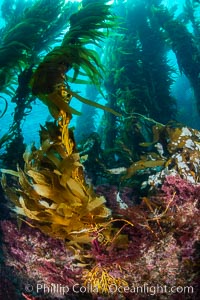
The Kelp Forest of San Clemente Island, California. A kelp forest. Giant kelp grows rapidly, up to 2' per day, from the rocky reef on the ocean bottom to which it is anchored, toward the ocean surface where it spreads to form a thick canopy. Myriad species of fishes, mammals and invertebrates form a rich community in the kelp forest. Lush forests of kelp are found throughout California's Southern Channel Islands.
Species: Giant kelp, Macrocystis pyrifera
Location: San Clemente Island, California
Image ID: 34611
Species: Giant kelp, Macrocystis pyrifera
Location: San Clemente Island, California
Image ID: 34611
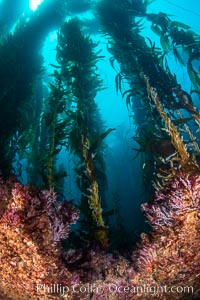
The Kelp Forest of San Clemente Island, California. A kelp forest. Giant kelp grows rapidly, up to 2' per day, from the rocky reef on the ocean bottom to which it is anchored, toward the ocean surface where it spreads to form a thick canopy. Myriad species of fishes, mammals and invertebrates form a rich community in the kelp forest. Lush forests of kelp are found throughout California's Southern Channel Islands.
Species: Giant kelp, Macrocystis pyrifera
Location: San Clemente Island, California
Image ID: 34612
Species: Giant kelp, Macrocystis pyrifera
Location: San Clemente Island, California
Image ID: 34612
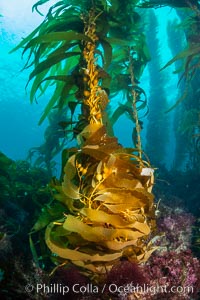
The Kelp Forest of San Clemente Island, California. A kelp forest. Giant kelp grows rapidly, up to 2' per day, from the rocky reef on the ocean bottom to which it is anchored, toward the ocean surface where it spreads to form a thick canopy. Myriad species of fishes, mammals and invertebrates form a rich community in the kelp forest. Lush forests of kelp are found throughout California's Southern Channel Islands.
Species: Giant kelp, Macrocystis pyrifera
Location: San Clemente Island, California
Image ID: 34613
Species: Giant kelp, Macrocystis pyrifera
Location: San Clemente Island, California
Image ID: 34613
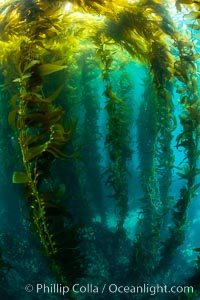
The Kelp Forest of San Clemente Island, California. A kelp forest. Giant kelp grows rapidly, up to 2' per day, from the rocky reef on the ocean bottom to which it is anchored, toward the ocean surface where it spreads to form a thick canopy. Myriad species of fishes, mammals and invertebrates form a rich community in the kelp forest. Lush forests of kelp are found throughout California's Southern Channel Islands.
Species: Giant kelp, Macrocystis pyrifera
Location: San Clemente Island, California
Image ID: 34614
Species: Giant kelp, Macrocystis pyrifera
Location: San Clemente Island, California
Image ID: 34614
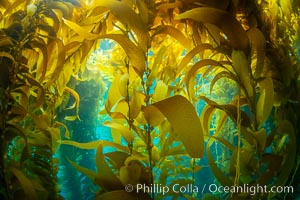
The Kelp Forest of San Clemente Island, California. A kelp forest. Giant kelp grows rapidly, up to 2' per day, from the rocky reef on the ocean bottom to which it is anchored, toward the ocean surface where it spreads to form a thick canopy. Myriad species of fishes, mammals and invertebrates form a rich community in the kelp forest. Lush forests of kelp are found throughout California's Southern Channel Islands.
Species: Giant kelp, Macrocystis pyrifera
Location: San Clemente Island, California
Image ID: 34615
Species: Giant kelp, Macrocystis pyrifera
Location: San Clemente Island, California
Image ID: 34615
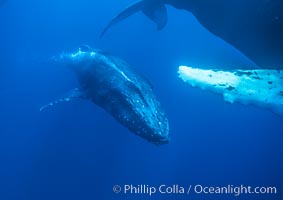
Humpback whale male escort emits a stream of bubbles during competitive group socializing. The whale is swimming so fast that the bubbles pass back alongside the whale.
Species: Humpback whale, Megaptera novaeangliae
Location: Maui, Hawaii
Image ID: 02855
Species: Humpback whale, Megaptera novaeangliae
Location: Maui, Hawaii
Image ID: 02855

Male humpback whale bubble streaming underwater. The male escort humpback whale seen here is emitting a curtain of bubbles as it swims behind a mother and calf (barely seen in the distance).
Species: Humpback whale, Megaptera novaeangliae
Location: Maui, Hawaii
Image ID: 04434
Species: Humpback whale, Megaptera novaeangliae
Location: Maui, Hawaii
Image ID: 04434
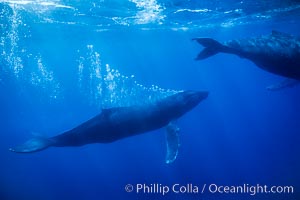
Adult male humpback whale bubble streaming underwater. The male escort humpback whale seen here is emitting a curtain of bubbles as it swims behind a female during competitive group activities. The bubble curtain may be meant as warning or visual obstruction to other nearby male whales interested in the female.
Species: Humpback whale, Megaptera novaeangliae
Location: Maui, Hawaii
Image ID: 04444
Species: Humpback whale, Megaptera novaeangliae
Location: Maui, Hawaii
Image ID: 04444
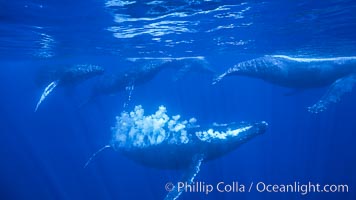
Male North Pacific humpback whale streams a trail of bubbles. The primary male escort whale (center) creates a curtain of bubbles underwater as it swims behind a female (right), with other challenging males trailing behind in a competitive group. The bubbles may be a form of intimidation from the primary escort towards the challenging escorts.
Species: Humpback whale, Megaptera novaeangliae
Location: Maui, Hawaii
Image ID: 05968
Species: Humpback whale, Megaptera novaeangliae
Location: Maui, Hawaii
Image ID: 05968
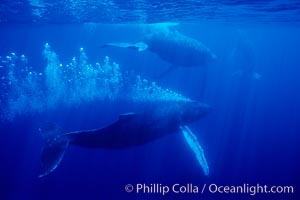
Adult male north Pacific humpback whale bubble streaming underwater in the midst of a competitive group. The male escort humpback whale seen here is emitting a curtain of bubbles as it swims closely behind a female, . The bubble curtain may be meant as warning or visual obstruction to other nearby males interested in the female.
Species: Humpback whale, Megaptera novaeangliae
Location: Maui, Hawaii
Image ID: 05999
Species: Humpback whale, Megaptera novaeangliae
Location: Maui, Hawaii
Image ID: 05999

Adult male north Pacific humpback whale bubble streaming underwater in the midst of a competitive group. The male escort humpback whale seen here is emitting a curtain of bubbles as it swims closely behind a female, . The bubble curtain may be meant as warning or visual obstruction to other nearby males interested in the female.
Species: Humpback whale, Megaptera novaeangliae
Location: Maui, Hawaii
Image ID: 06037
Species: Humpback whale, Megaptera novaeangliae
Location: Maui, Hawaii
Image ID: 06037
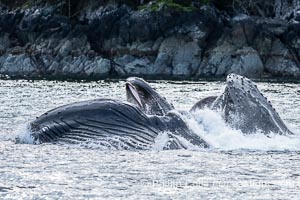
Humpback whales bubblenet feeding in Southeast Alaska. Coordinated bubble-net feeding is a specialized cooperative feeding technique used by humpback whales, where a group of whales works together to trap fish or krill in a net of bubbles then lunge through to feed.
Species: Humpback whale, Megaptera novaeangliae
Location: Sitka Sound, Alaska
Image ID: 40928
Species: Humpback whale, Megaptera novaeangliae
Location: Sitka Sound, Alaska
Image ID: 40928

Humpback whales bubblenet feeding in Southeast Alaska. Coordinated bubble-net feeding is a specialized cooperative feeding technique used by humpback whales, where a group of whales works together to trap fish or krill in a net of bubbles then lunge through to feed.
Species: Humpback whale, Megaptera novaeangliae
Location: Sitka Sound, Alaska
Image ID: 40929
Species: Humpback whale, Megaptera novaeangliae
Location: Sitka Sound, Alaska
Image ID: 40929

Humpback whales bubblenet feeding in Southeast Alaska. Coordinated bubble-net feeding is a specialized cooperative feeding technique used by humpback whales, where a group of whales works together to trap fish or krill in a net of bubbles then lunge through to feed.
Species: Humpback whale, Megaptera novaeangliae
Location: Sitka Sound, Alaska
Image ID: 40930
Species: Humpback whale, Megaptera novaeangliae
Location: Sitka Sound, Alaska
Image ID: 40930
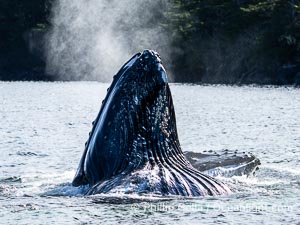
Humpback whales bubblenet feeding in Southeast Alaska. Coordinated bubble-net feeding is a specialized cooperative feeding technique used by humpback whales, where a group of whales works together to trap fish or krill in a net of bubbles then lunge through to feed.
Species: Humpback whale, Megaptera novaeangliae
Location: Sitka Sound, Alaska
Image ID: 40931
Species: Humpback whale, Megaptera novaeangliae
Location: Sitka Sound, Alaska
Image ID: 40931

Kelp fronds and pneumatocysts. Pneumatocysts, gas-filled bladders, float the kelp plant off the ocean bottom toward the surface and sunlight, where the leaf-like blades and stipes of the kelp plant grow fastest. Giant kelp can grow up to 2' in a single day given optimal conditions. Epic submarine forests of kelp grow throughout California's Southern Channel Islands.
Species: Giant kelp, Macrocystis pyrifera
Location: San Clemente Island, California
Image ID: 23424
Species: Giant kelp, Macrocystis pyrifera
Location: San Clemente Island, California
Image ID: 23424
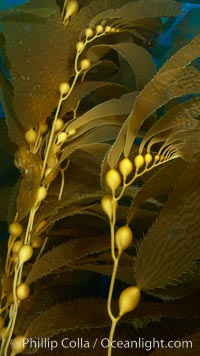
Kelp fronds and pneumatocysts. Pneumatocysts, gas-filled bladders, float the kelp plant off the ocean bottom toward the surface and sunlight, where the leaf-like blades and stipes of the kelp plant grow fastest. Giant kelp can grow up to 2' in a single day given optimal conditions. Epic submarine forests of kelp grow throughout California's Southern Channel Islands.
Species: Giant kelp, Macrocystis pyrifera
Location: San Clemente Island, California
Image ID: 23430
Species: Giant kelp, Macrocystis pyrifera
Location: San Clemente Island, California
Image ID: 23430
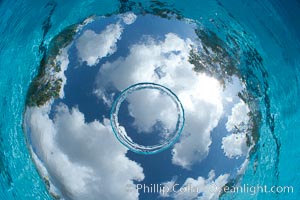
Underwater bubble ring, a stable toroidal pocket of air.
Image ID: 25282
Image ID: 25282

Underwater bubble ring, a stable toroidal pocket of air.
Image ID: 25285
Image ID: 25285
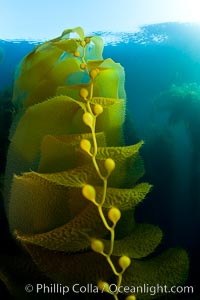
Kelp fronds and pneumatocysts. Pneumatocysts, gas-filled bladders, float the kelp plant off the ocean bottom toward the surface and sunlight, where the leaf-like blades and stipes of the kelp plant grow fastest. Giant kelp can grow up to 2' in a single day given optimal conditions. Epic submarine forests of kelp grow throughout California's Southern Channel Islands.
Species: Giant kelp, Macrocystis pyrifera
Location: San Clemente Island, California
Image ID: 25399
Species: Giant kelp, Macrocystis pyrifera
Location: San Clemente Island, California
Image ID: 25399
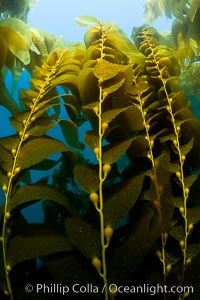
Kelp fronds and pneumatocysts. Pneumatocysts, gas-filled bladders, float the kelp plant off the ocean bottom toward the surface and sunlight, where the leaf-like blades and stipes of the kelp plant grow fastest. Giant kelp can grow up to 2' in a single day given optimal conditions. Epic submarine forests of kelp grow throughout California's Southern Channel Islands.
Species: Giant kelp, Macrocystis pyrifera
Location: San Clemente Island, California
Image ID: 25403
Species: Giant kelp, Macrocystis pyrifera
Location: San Clemente Island, California
Image ID: 25403
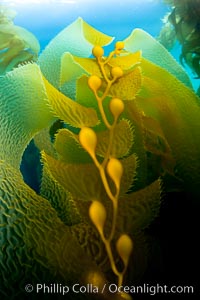
Kelp fronds and pneumatocysts. Pneumatocysts, gas-filled bladders, float the kelp plant off the ocean bottom toward the surface and sunlight, where the leaf-like blades and stipes of the kelp plant grow fastest. Giant kelp can grow up to 2' in a single day given optimal conditions. Epic submarine forests of kelp grow throughout California's Southern Channel Islands.
Species: Giant kelp, Macrocystis pyrifera
Location: San Clemente Island, California
Image ID: 25412
Species: Giant kelp, Macrocystis pyrifera
Location: San Clemente Island, California
Image ID: 25412
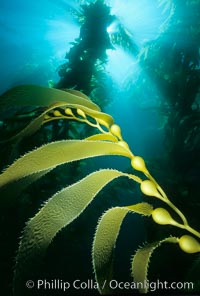
Kelp frond showing pneumatocysts.
Species: Giant kelp, Macrocystis pyrifera
Location: San Clemente Island, California
Image ID: 00617
Species: Giant kelp, Macrocystis pyrifera
Location: San Clemente Island, California
Image ID: 00617

Kelp frond showing pneumatocysts.
Species: Giant kelp, Macrocystis pyrifera
Location: San Clemente Island, California
Image ID: 00628
Species: Giant kelp, Macrocystis pyrifera
Location: San Clemente Island, California
Image ID: 00628
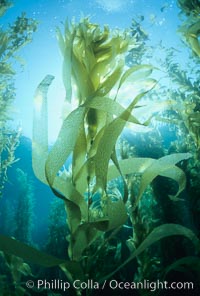
Kelp fronds.
Species: Giant kelp, Macrocystis pyrifera
Location: San Clemente Island, California
Image ID: 01273
Species: Giant kelp, Macrocystis pyrifera
Location: San Clemente Island, California
Image ID: 01273
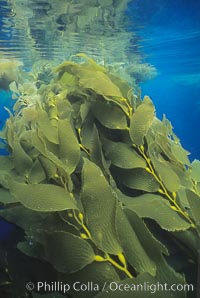
Kelp plants growing toward surface and spreading to form a canopy.
Species: Giant kelp, Macrocystis pyrifera
Location: San Clemente Island, California
Image ID: 01293
Species: Giant kelp, Macrocystis pyrifera
Location: San Clemente Island, California
Image ID: 01293
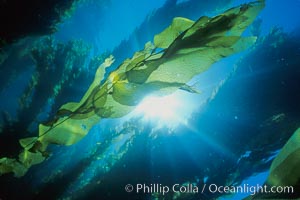
Kelp fronds and forest.
Species: Giant kelp, Macrocystis pyrifera
Location: San Clemente Island, California
Image ID: 01497
Species: Giant kelp, Macrocystis pyrifera
Location: San Clemente Island, California
Image ID: 01497